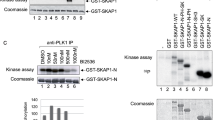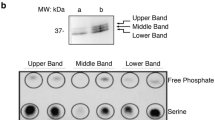Abstract
POLYOMA virus middle T-antigen converts normal fibroblasts to a fully transformed, tumorigenic phenotype1. It achieves this, at least in part, by binding and activating one of the non-receptor tyrosine kinases, pp60c-src, pp62c-yes or pp59c-fyn (reviewed in refs 2 and 3). As a result, middle T-antigen itself is phosphorylated on tyrosine residues4,5, one of which (Tyr 315) acts as a binding site for the SH2 domains of phosphatidylinositol-3'OH kinase 85K sub-unit6–8. Here we show that another tyrosine phosphorylation site in middle T-antigen (Tyr 250; refs 4, 5) acts as a binding region for the SH2 domain of the transforming protein Shc9. This results in Shc also becoming tyrosine-phosphorylated and binding to the SH2 domain of Grb2 (ref. 10). This probably stimulates p21ras activity through the mammalian homologue of the Drosophila guanine-nucleotide-exchange factor Sos (reviewed in ref. 11). We suggest that middle T-antigen transforms cells by acting as a functional homologue of an activated tyrosine kinase-associated growth-factor receptor.
This is a preview of subscription content, access via your institution
Access options
Subscribe to this journal
Receive 51 print issues and online access
$199.00 per year
only $3.90 per issue
Buy this article
- Purchase on Springer Link
- Instant access to full article PDF
Prices may be subject to local taxes which are calculated during checkout
Similar content being viewed by others

References
Treisman, R., Novak, U., Favaloro, J. & Kamen, R. Nature 292, 595–600 (1981).
Courtneidge, S. A. Cancer Surv. 5, 173–182 (1986).
Kaplan, D. R., Pallas, D. C., Morgan, W., Schaffhausen, B. & Roberts, T. M. Biochim. biophys. Acta 948, 345–364 (1989).
Harvey, R., Oostra, B. A., Belsham, G. J., Gillett, P. & Smith, A. E. Molec. cell. Biol. 4, 1334–1342 (1984).
Hunter, T., Hutchinson, M. A. & Eckhart, W. EMBO J. 3, 73–79 (1984).
Talmage, D. A. et al. Cell 59, 55–65 (1989).
Yoakim, M. et al. J. Virol. 66, 5485–5491 (1992).
Auger, K. R., Carpenter, C. L., Shoelson, S. E., Piwnica-Worms, H. & Cantley, L. C. J. biol. Chem. 267, 5408–5415 (1992).
Pelicci, G. et al. Cell 70, 93–104 (1992).
Rozakis-Adcock, M. et al. Nature 360, 689–692 (1992).
McCormick, F. Nature 363, 15–16 (1993).
McGlade, J., Cheng, A., Pelicci, G., Pelicci, P. G. & Pawson, T. Proc. natn. Acad. Sci. U.S.A. 89, 8869–8873 (1992).
Griffin, B. E. et al. Cold Spring Harb. Symp. quant. Biol. 1, 271–283 (1980).
Markland, W. & Smith, A. E. Biochim. biophys. Acta 907, 299–321 (1987).
Druker, B. J., Ling, L. E., Cohen, B., Roberts, T. M. & Schaffhausen, B. S. J. Virol. 64, 4454–4461 (1990).
Dilworth, S. M. & Horner, V. P. J. Virol. 67, 2235–2244 (1993).
Carmichael, G., Schaffhausen, B. S., Mandel, G., Liang, T. J. & Benjamin, T. L. Proc. natn. Acad. Sci. U.S.A. 81, 679–683 (1984).
Markland, W. et al. J. Virol. 59, 384–391 (1986).
Dilworth, S. M. EMBO J. 1, 1319–1328 (1982).
Courtneidge, S. A. & Heber, A. Cell 50, 1031–1037 (1987).
Kaplan, D. R. et al. Cell 50, 1021–1029 (1987).
Raptis, L. et al. J. Virol. 65, 5203–5210 (1991).
Jelinek, M. A. & Hassell, J. A. Oncogene 7, 1687–1698 (1992).
Lowenstein, E. J. et al. Cell 70, 431–442 (1992).
Songyang, Z. et al. Cell 72, 767–778 (1993).
Segatto, O. et al. Oncogene 8, 2105–2112 (1993).
Laemmli, U. K. Nature 227, 680–685 (1970).
Ho, S. N., Hunt, H. D., Horton, R. M., Pullen, J. K. & Pease, L. R. Gene 77, 51–59 (1989).
Smith, D. B. & Johnson, K. S. Gene 67, 31–40 (1988).
Author information
Authors and Affiliations
Rights and permissions
About this article
Cite this article
Dilworth, S., Brewster, C., Jones, M. et al. Transformation by polyoma virus middle T-antigen involves the binding and tyrosine phosphorylation of Shc. Nature 367, 87–90 (1994). https://doi.org/10.1038/367087a0
Received:
Accepted:
Issue Date:
DOI: https://doi.org/10.1038/367087a0
This article is cited by
-
Polyoma virus middle T antigen and its role in identifying cancer-related molecules
Nature Reviews Cancer (2002)
-
Cell transformation by the middle T-antigen of polyoma virus
Oncogene (2001)
-
Tyrosine kinase signalling in breast cancer: Tyrosine kinase-mediated signal transduction in transgenic mouse models of human breast cancer
Breast Cancer Research (2000)
-
Human endothelial cells expressing polyoma middle T induce tumors
Oncogene (2000)
-
Signal transduction in mammary tumorigenesis: a transgenic perspective
Oncogene (2000)
Comments
By submitting a comment you agree to abide by our Terms and Community Guidelines. If you find something abusive or that does not comply with our terms or guidelines please flag it as inappropriate.


